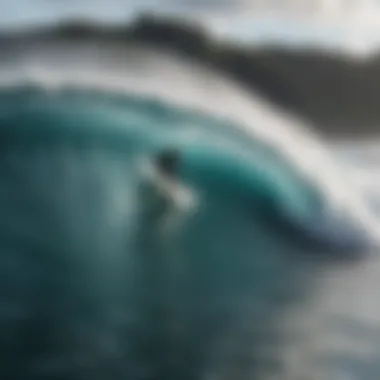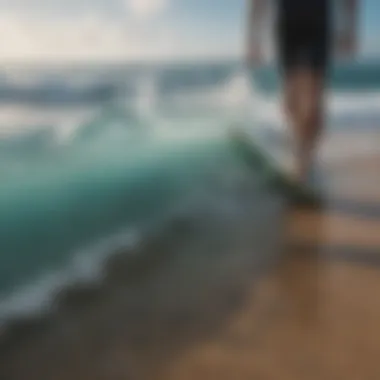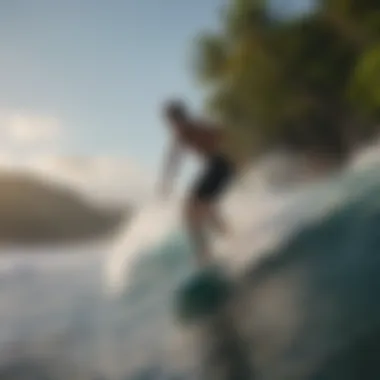Ultimate Guide to Surfing on the Big Island


Intro
The Big Island of Hawaii stands as a premier destination for surfing enthusiasts worldwide. It presents diverse surf spots catering to all skill levels, from beginners catching their first waves to seasoned surfers seeking challenging swells. With its breathtaking landscapes and unique ocean conditions, surfing here is not just a sport but an experience that intertwines with the rich culture of Hawaii. This guide delves into the distinctive surfing locations, wave dynamics, essential equipment, and tips to enhance your overall surfing experience on the Big Island.
Extreme Sports Overview
Definition of Extreme Sports
Extreme sports typically involve a high degree of risk, adrenaline, and varying degrees of danger. Surfing, with its need for skill and bravery, perfectly fits this definition. Surfers must navigate unpredictable waves and potential hazards in the ocean.
History and Evolution
The history of surfing in Hawaii dates back to ancient times, when it was not only a sport but also an integral part of the culture and rituals of the native Hawaiian people. European explorers documented these traditions in the 18th century, but it was not until the 20th century that surfing surged in popularity globally, evolving into various styles and techniques.
Popular Extreme Sports Disciplines
Beyond surfing, extreme sports encompass a wide range of activities, including snowboarding, rock climbing, and skydiving. Surfing, however, remains one of the most iconic and culturally rich extreme sports.
Gear and Equipment
Essential Gear for Surfing
To ensure safety and performance while surfing on the Big Island, having the right gear is crucial. Here are some essentials:
- Surfboard: Choose the right type based on your skill level and the wave conditions.
- Wetsuit: Depending on the season, a wetsuit provides insulation against cooler waters.
- Leash: A safety measure to keep your board attached during rides.
- Wax: To enhance grip on your board.
Gear Reviews and Comparisons
Among the popular surfboard brands, Channel Islands and Firewire are often praised for their innovative designs and materials. Their boards cater to diverse surfing styles and preferences, which makes them a good consideration for any surfer.
Safety Ratings and Certifications
When selecting gear, especially inflatable boards or water safety equipment, look for safety ratings and certifications that ensure quality and longevity.
Training and Preparation
Physical Conditioning and Fitness Tips
Surfing requires strong core muscles, balance, and endurance. Regular strength training and cardiovascular exercises can significantly enhance your performance on the waves. Yoga is also highly recommended, as it improves flexibility and balance.
Mental Preparation Techniques
Mental focus is vital when tackling waves, especially when conditions are unpredictable. Techniques like visualization can help surfers prepare mentally for their rides, improving overall confidence and performance.
Training Regimens for Surfing
Creating a structured training regimen that incorporates physical conditioning, practice, and mental preparation is important for both novice and experienced surfers. Consider varying your workouts to include strength, endurance, and technique refinement.
Locations and Destinations
Top Destinations for Surfing on the Big Island
- Punaluu Black Sand Beach: Accessible waves suitable for beginners and novices.
- Kaimu Beach: Great for intermediate surfers, with more challenging conditions.
- Hilo Bay: Often features larger swells, ideal for advanced surfers.
- Kona Coast: Known for consistent waves, favored by surfers of all levels.
Travel Tips and Guides
When planning your surfing trip to the Big Island, consider the season and weather patterns. The best season for surfing generally spans from May to September. Ensure you check local surf reports to catch the best conditions.
The Big Island offers diverse waves, catering to all surfing abilities. Understanding the local surf spots can elevate your experience and ensure a great adventure.
Prelude to Surfing on the Big Island
Surfing on the Big Island is not just a sport; it is a vital part of the island's identity and culture. This section outlines the significance of surfing in this unique environment, emphasizing both the benefits and considerations for enthusiasts who seek to ride its waters. With diverse surf spots and varying wave conditions, the Big Island caters to all skill levels.
Overview of Hawaii's Surf Culture
Hawaii is often recognized as the birthplace of surfing, with deep roots in its ancient traditions. In Hawaiian culture, surfing was more than recreation; it was a rite of passage, a means of connection to the ocean, and a demonstration of skill and bravery. The ancient Hawaiians crafted wooden surfboards known as olo for chiefs and alaia for commoners, showcasing social status through their surfing. Today, this cultural respect for the ocean endures, where a blend of history, tradition, and modern sporting spirit intertwine.


The surfing community in Hawaii fosters an inclusive atmosphere, welcoming newcomers while still honoring the sacredness of the waves. This environment allows surfers to appreciate the craft while contributing to a deeper understanding of local customs and respects to the ocean.
The Importance of the Big Island
The Big Island stands out as a premier surfing destination within the Hawaiian archipelago. Its coastline spans more than 100 miles, offering varied conditions suited to different surfing experiences. From the crystal-clear waters of Kona to the more rugged Hilo side, the Big Island presents endless opportunities for exploration.
Surf conditions vary dramatically due to geographic factors such as wind patterns, underwater topography, and seasonal changes. This variation results in a rich tapestry of surf spots, appealing to seasoned riders and novices alike. For instance, the famous reef breaks provide thrilling challenges for advanced surfers, while mellow beach breaks cater to those just beginning to master their skills.
Surfers might also find a diverse marine environment. Rich ocean life includes colorful fish, coral reefs, and occasionally, dolphins or turtles that can be spotted while riding waves. This relationship between surfers and nature reinforces the importance of environmental stewardship.
As a backdrop for surfers, the cultural landscape adds to the island's allure. From immersive local festivals celebrating Hawaiian heritage to opportunities for gatherings among surfers, the Big Island is not merely a place to surf but a hub of community and cultural enrichment.
Overall, surfing on the Big Island is an experience that transcends the act of riding waves. It invites engagement with the cultural narratives that shape the islands while offering practical considerations for an enriching adventure.
Top Surf Spots on the Big Island
The Big Island of Hawaii presents diverse surfing opportunities, each with its unique characteristics. Identifying the top surf spots is vital for any surfer, whether a novice or seasoned expert. The varied landscapes, from the inviting waters of the Kona Coast to the challenging waves on the Hilo Side, cater to different skill levels and preferences. Understanding surf conditions at these spots enhances the surfing experience. By knowing where to best surf, enthusiasts can avoid crowding and find the ideal waves for their skill sets.
Kona Coast
The Kona Coast is one of the prominent surf destinations on the Big Island. Its stunning scenery and warm waters attract many surfers every year.
Description of Surf Conditions
The surf conditions along the Kona Coast are generally favorable. The waves here can range from mellow to powerful, depending on specific break locations. With volcanic rock and sandy bottoms, the coast offers a mix, making it suitable for various surfers. Many surfers appreciate the reliable wave breaks found here, particularly in the summer months. However, this area can experience more significant swells, especially in winter, which makes it essential for surfers to assess their skill levels before hitting the water.
Best Time to Surf
The best time to surf the Kona Coast typically spans from late spring to early fall. During this period, the waves are more consistent and manageable. Surfers looking for smaller, less powerful waves should consider the summer months. In contrast, winter brings larger swells that challenge more experienced surfers. It is crucial to plan your surf trip with regard to seasonal changes to maximize enjoyment and safety.
Local Amenities
The Kona Coast provides various local amenities that enhance the surfing experience significantly. Surfers will find numerous surf shops offering rentals and equipment for beginners. In addition, many restaurants and cafes line the coast, offering post-surf nourishment. Showers and restrooms are accessible at popular surf spots. However, it is essential to keep in mind that facilities may be busy during peak season, so arriving early can help avoid crowds.
Hilo Side
The Hilo Side offers a different surfing experience, characterized by its lush landscapes and more variable wave conditions.
Surf Guidelines
Understanding surf guidelines on the Hilo Side is essential to ensure safety and respect for the local surf culture. The guidelines vary depending on the surf break, with some areas being more suited for experienced surfers. It is vital to follow local rules, such as right-of-way in the water. This respect helps maintain a positive environment for everyone and reduces the likelihood of accidents.
Accessibility
Accessing surf breaks on the Hilo Side can be straightforward or challenging, depending on the location. Some spots are easily reachable from the main roads, while others require a bit of hiking. It is advisable for surfers to check local maps and guides before venturing out. Those new to the area may discover some hidden gems off the beaten path. However, ensure you are mindful of the terrain, as it can be rugged and may pose challenges for some.
Safety Considerations
Safety is a primary concern when surfing on the Hilo Side. This area has varying conditions, which can include strong currents or sharp coral. It is essential to assess conditions before entering the water. Understanding weather changes, tide patterns, and local wildlife are also crucial. Surfers should be aware of their skill levels and not attempt breaks beyond their ability to avoid dangerous situations.
Seasonal Considerations for Surfing
Understanding seasonal considerations is vital for anyone looking to surf on the Big Island. Each season brings unique conditions that influence wave patterns, surf locations, and the level of skill required. This knowledge can significantly affect your surfing experience.
Winter Swells
Winter on the Big Island introduces powerful conditions ideal for seasoned surfers. Swells during this time are larger and generally more consistent, making the winter months popular for surf enthusiasts.
Notable Locations
Key locations during winter include spots like Javier's and Pine Trees. These areas are well-known for their excellent winter waves. The Javier's break is particularly appealing due to its consistent swells that attract experienced surfers from around the world. It often features rights and lefts, providing versatility depending on the swell direction.
The unique feature of Pine Trees is that its waves can be forgiving at times while challenging at others. Beginners may find it less intimidating than some other winter spots, but it can still produce powerful waves, which can be a concern for less experienced surf-ers during peak swell.
Wave Characteristics
Wave characteristics in winter are defined by their size and power. The waves are often steep, fast, and can reach heights of up to 12 feet or more under certain conditions. This intensity is significant for experienced surfers. For novices, caution is advised as the currents can be unpredictable.


The key characteristic to note is the energy level of these winter swells. While they offer thrilling rides for advanced surfers, the risks associated with the powerful conditions must also be considered.
Summer Conditions
As the seasons shift to summer, conditions change significantly. Surfers can experience calmer, more manageable waves, which can be advantageous for different surf levels.
Calmer Waters
The summer months present calmer waters that many surfers find appealing. The swells become smaller and more manageable, making it an excellent time for those looking to improve their skills. Popular locations during this time include Kaimu Black Sand Beach and Kona Coast.
A unique feature of Kaimu is its scenic beauty and gentle waves, particularly favored by those venturing into surfing for the first time.
Suitable for Beginners
Summer conditions are more suitable for beginners due to the less powerful waves. The warm waters also provide a more comfortable environment for long sessions. It is essential for beginners to take advantage of this period to gain confidence in their skills. Locations like Magic Sands Beach are particularly recommended for newcomers due to their forgiving breaks and local surf schools available for lessons.
This emphasis on summer conditions not only enhances the surfing experience for new enthusiasts but also preserves a level of safety that is critical for those just starting.
In summary, understanding seasonal surfing conditions on the Big Island is essential for any surf enthusiasts. Whether you are riding powerful winter swells or enjoying the calmer summer waves, each season offers its own character and opportunities.
Understanding Surfing Safety
Surfing safety is crucial for anyone looking to ride the waves on the Big Island. Understanding the various hazards can make a significant difference in not only enjoying the surf but also ensuring that one returns safely after each session. This section outlines essential elements to keep in mind, emphasizing the benefits of recognizing hazards and adhering to local guidelines.
Identifying Hazardous Conditions
Youthful Calling Waves
Youthful calling waves can be thrilling yet unpredictable. These waves often attract surfers, yet they can carry significant risks. They are characterized by their energy and breaking patterns that may vary by the moment. Newer surfers might find these waves inviting; however, their inconsistency can lead to dangerous situations.
Key characteristics include rapid changes in height and force, which can catch an inexperienced surfer off guard. While experiencing youthfully powerful waves is exciting, it’s essential to respect their nature and understand when to avoid them for safety.
Advantages of recognizing youthful calling waves include improved timing for catching waves and better judgment regarding surf conditions. However, the disadvantage is the steep learning curve required to master handling these waves effectively.
Weather Factors
Weather factors also play a vital role in surfing safety. Changes in weather can alter ocean conditions, introducing unpredictable currents and stronger waves. Key components include wind direction, rainfall, and storm systems that could roll in unexpectedly. These conditions can create hazards that may not be visible from shore.
Understanding weather patterns provides surfers with the ability to make informed decisions about when to surf or whether to postpone. The advantage here is increased awareness and preparedness to manage potentially unsafe conditions. On the flip side, not paying attention to the weather can lead to dangerous encounters with nature's power.
Local Guidelines
Respect for Surf Etiquette
Respecting surf etiquette is essential in fostering a positive surfing experience for everyone involved. Surf etiquette covers the unspoken rules of the water, such as taking turns and not dropping in on another rider's wave. Recognizing and adhering to these norms help maintain harmony among surfers.
The key characteristic of this etiquette is mutual respect. It provides structure within what can be chaotic water conditions. By following these guidelines, surfers can enhance their enjoyment while also promoting safety.
On the positive side, respect for surf etiquette minimizes accidents and conflicts in the water. However, ignoring established protocols can lead to tension and riskier situations, potentially harming others and oneself.
Environmental Practices
Environmental practices play a critical role in ensuring that surf spots remain pristine and accessible for future generations. This includes not littering, respecting wildlife, and being mindful of one’s impact on local ecosystems.
The key feature of environmentally friendly practices is sustainability, aiming to protect the ocean and its surroundings while enjoying the sport. Practicing environmental stewardship enhances the experience and preserves the beauty of the surf spots. Conversely, neglecting these responsibilities can result in long-term damage to the very environments surfers cherish.
In summary, understanding surfing safety is integral to an enjoyable surfing experience. Awareness of hazards, adherence to etiquette, and respect for the environment all contribute to a safe and fulfilling adventure on the waves.
Gear Selection for Surfing
Selecting the right gear is vital for obtaining the maximum enjoyment and efficiency while surfing on the Big Island. Different surfboards and accessories cater to varied skill levels and surfing conditions. A thoughtful approach to gear selection can enhance a surfer’s experience and ensure safety and performance in the water.
Type of Surfboards
Shortboards vs. Longboards
Understanding the differences between shortboards and longboards can greatly affect a surfer's performance on the waves. Shortboards are characterized by their narrow width and reduced length, making them ideal for executing quick maneuvers and tricks. They are preferred by advanced surfers who seek speed and agility. However, shortboards can be more challenging for beginners due to their less stable design.


Choosing the Right Size
Choosing the correct board size is crucial for performance and comfort while surfing. A beginner should consider a larger surfboard to assist in paddling and stability. Typically, beginners are recommended to use boards that are at least 8 to 9 feet in length, as these boards offer better buoyancy.
For experienced surfers, the right size may vary significantly based on personal preferences, style, and the specific conditions of the surf. A board’s width also plays a critical role; wider boards provide more stability, while narrower boards allow for faster cutting through the water. Ultimately, the right size enhances both performance level and enjoyment during a surf session.
Wetsuits and Accessories
Material Considerations
The material of wetsuits is essential for ensuring warmth and flexibility while surfing. Most wetsuits are made from neoprene, which provides insulation. Different thicknesses exist, allowing surfers to select suits based on the water temperature in the Big Island. Thicker suits offer more warmth but can limit flexibility. Conversely, thinner suits provide more freedom of movement, ideal for warmer climates. Therefore, selecting the appropriate material and thickness contributes directly to a surfer's comfort and performance in the water.
Layering for Comfort
Layering is an often overlooked aspect of comfort in surfing gear. By wearing different layers, surfers can effectively manage their body temperature. The base layer can wick moisture away from the skin, allowing surfers to stay dry and warm. A mid-layer can provide insulation, while an outer layer helps to protect against wind and water.
The benefit of layering lies in the ability to easily adjust to changing conditions. For example, a surfer can remove or add layers based on temperature fluctuations throughout the day. This adaptability makes it a wise choice for those spending long hours in the ocean.
"Choosing the right gear directly influences your comfort, performance, and overall experience while surfing."
In summary, gear selection can have profound impacts on the surfing experience. Understanding the types of surfboards, their sizes, wetsuit materials, and layering techniques enables surfers to navigate the waters of the Big Island effectively. This knowledge ensures that surfers are well-prepared for the adventures ahead.
Cultural Significance of Surfing
Surfing in Hawaii transcends the sport itself; it is deeply embedded in the state’s cultural fabric. On the Big Island, the act of riding waves plays a vital role in local identity and community cohesion. It is not merely about the thrill of the ocean; surfing encompasses heritage, traditions, and social values that have evolved over centuries. Understanding this significance provides a richer appreciation for every surf session, enriching the experience for all participants.
Historical Context
Origins in Hawaiian Culture
Surfing's origins in Hawaiian culture date back to ancient times. It was not just a physical activity but a spiritual practice, reflecting a connection between the people and the ocean. Initially, different board designs represented various social standings. Surfing became an expression of community and identity, with the best waves being a source of competition among skilled riders.
The practice has roots in the Polynesian voyaging tradition. It served as a rite of passage and continued to symbolize cultural pride and resilience. Understanding this historical backdrop is crucial for surfers today. It reinforces the idea that each wave caught is part of a larger narrative, linking modern practices with ancestral traditions.
Evolution of Surfing Practices
As time progressed, surfing on the Big Island saw significant changes influenced by social, economic, and environmental factors. Traditional wooden surfboards evolved into more modern materials, reflecting rising technologies and innovations in surf culture. However, while physical equipment might have changed, the underlying principles of respect for the ocean and its resources have remained consistent.
Modern surfing includes organized competitions that attract global attention and sponsors. These events often lead to increased tourism and variety in practicing styles. Nonetheless, discussions surrounding environmental sustainability present both challenges and opportunities. As surfers face the impact of climate change on wave patterns, adapting to modern practices yet maintaining respect for ancient traditions becomes crucial.
Modern-Day Trends
Competitive Surfing
Competitive surfing has taken a significant foothold on the Big Island, drawing surfers from around the world. Events such as the WSL competitions showcase incredible talent and skill. This platform not only highlights elite athletes but also inspires local surfers and newcomers to the sport.
The structured nature of competitive surfing helps develop a sense of community amongst participants. They share training tips and support each other during events. However, the focus on competition can sometimes overshadow the spiritual connection to surfing that many local practitioners cherish. Finding a balance between competition and cultural heritage is essential for the sustainability of the surfing community.
Impact on Local Communities
Modern surfing has broad societal impacts on the local communities of the Big Island. It fosters economic growth through tourism and associated industries such as surf schools and equipment rentals. Many locals benefit from these opportunities, reinforcing a cycle of growth.
However, an influx of tourists can create pressure on local ecosystems and cultural spaces. Local communities often find themselves negotiating visitor behavior regarding respect for cultural practices and environmental conservation. Thus, awareness and collaboration between locals and tourists can help maximize positive outcomes for both parties.
Surfing is not just a sport; it is a way of life that embodies community, culture, and respect for nature.
Closure and Additional Resources
In any exploration of the surfing culture at the Big Island, a clear conclusion helps connect the dots from experience to knowledge. Surfing here is not just a sport; it is an integral part of the local identity. The diverse surf spots cater to various skill levels, making it accessible for both seasoned athletes and beginners. Key takeaways from this discussion include understanding local surf conditions, recognizing seasonal patterns, and prioritizing safety in all surfing activities.
Recognizing the cultural significance adds a sense of responsibility to surfers. Acknowledging the origins of surfing in Hawaiian culture enhances appreciation for the sport. Engaging with the local community is essential as it fosters respect and understanding between surfers and residents. This respect is reflected in good surfer etiquette and sustainable practices during surf activities.
Additional resources extend the learning experience beyond this article. Various publications, online communities, and local guides provide valuable insights. As conditions can change, staying informed through these resources helps surfers navigate the dynamic environment of the Big Island.
Recap of Key Points
- Diverse Conditions: The surfing locations on the Big Island accommodate all skill levels.
- Cultural Significance: Understanding the roots of surfing enhances the overall experience.
- Safety is Paramount: Always prioritize safety and respect local guidelines.
- Seasonal Awareness: Different times of the year bring varying surf conditions, shaping the surfing experience.
"Surfing is not only about riding waves; it's about connecting with the spirit of the ocean and the culture that surrounds it."
Further Reading and Resources
- Hawaii Surf Guidebooks: Books like "Hawaii Surfing" by Mike McGreal provide detailed insights on surf spots and techniques.
- Local Surf Schools: Consider enrolling in programs offered by locations like Kona Surf Company for hands-on learning experiences.
- Online Forums and Communities: Websites such as Reddit can offer practical advice from various surfers who share their experiences and tips.
- Historical Overviews: For those interested in deeper insights into surfing culture, reference materials available on Britannica or Wikipedia can be invaluable.







